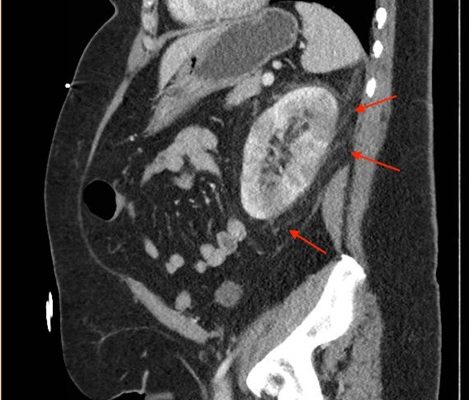Search By Topic
Found 15 Unique Results
Page 2 of 2
Page 2 of 2
Page 2 of 2
Acute Pyelonephritis with Perinephric Stranding on CT
DOI: https://doi.org/10.21980/J8BH0VA CT abdomen and pelvis with IV contrast showed neither nephrolithiasis nor diverticulitis, and instead showed heterogeneous enhancement of the left kidney with mild edematous enlargement and striated left nephrogram. Significant perinephric stranding (red arrows) was also noted and was consistent with severe acute pyelonephritis.
Hemodialysis in the Poisoned Patient
DOI: https://doi.org/10.21980/J88S68By the end of this cTBL, the learner will: 1) recognize laboratory abnormalities related to toxic alcohol ingestion; 2) calculate an anion gap and osmolal gap; 3) know the characteristics of drugs that are good candidates for HD; 4) discuss the management of patients with toxic alcohol ingestions; 5) discuss the management of patients with salicylate overdose; 6) know the indications for HD in patients with overdoses of antiepileptic drugs; 7) discuss the management of patients with lithium toxicity.
Renal Infarction from Type B Aortic Dissection
DOI: https://doi.org/10.21980/J8HG9GInitial abdominal images demonstrated a dissection flap; therefore, a CTA of the chest was also obtained. These images revealed a Stanford type B aortic dissection beginning just distal to the left subclavian artery and extending to the origin of the inferior mesenteric artery. The right renal artery arose from the true lumen of the dissection while the left renal artery arose from the false lumen. This case is interesting as imaging shows the lack of perfusion to the left kidney, residing in the retroperitoneum, which correlates with her non-descript abdominal and left flank pain.
Ectopic Kidney
DOI: https://doi.org/10.21980/J89058CT of the abdomen and pelvis revealed a normal left kidney and an ectopic, malrotated right kidney located in the pelvis (see white arrow).
Emergencies in Hemodialysis Patients
DOI: https://doi.org/10.21980/J81591By the end of this session, the learner will: 1) describe primary dialysis complications; 2) construct a full differential for a dialysis patient presenting with complications; 3) formulate an appropriate treatment and resuscitation in an acutely ill dialysis patient; 4) plan appropriate disposition and utilization of consultants for dialysis complications.



